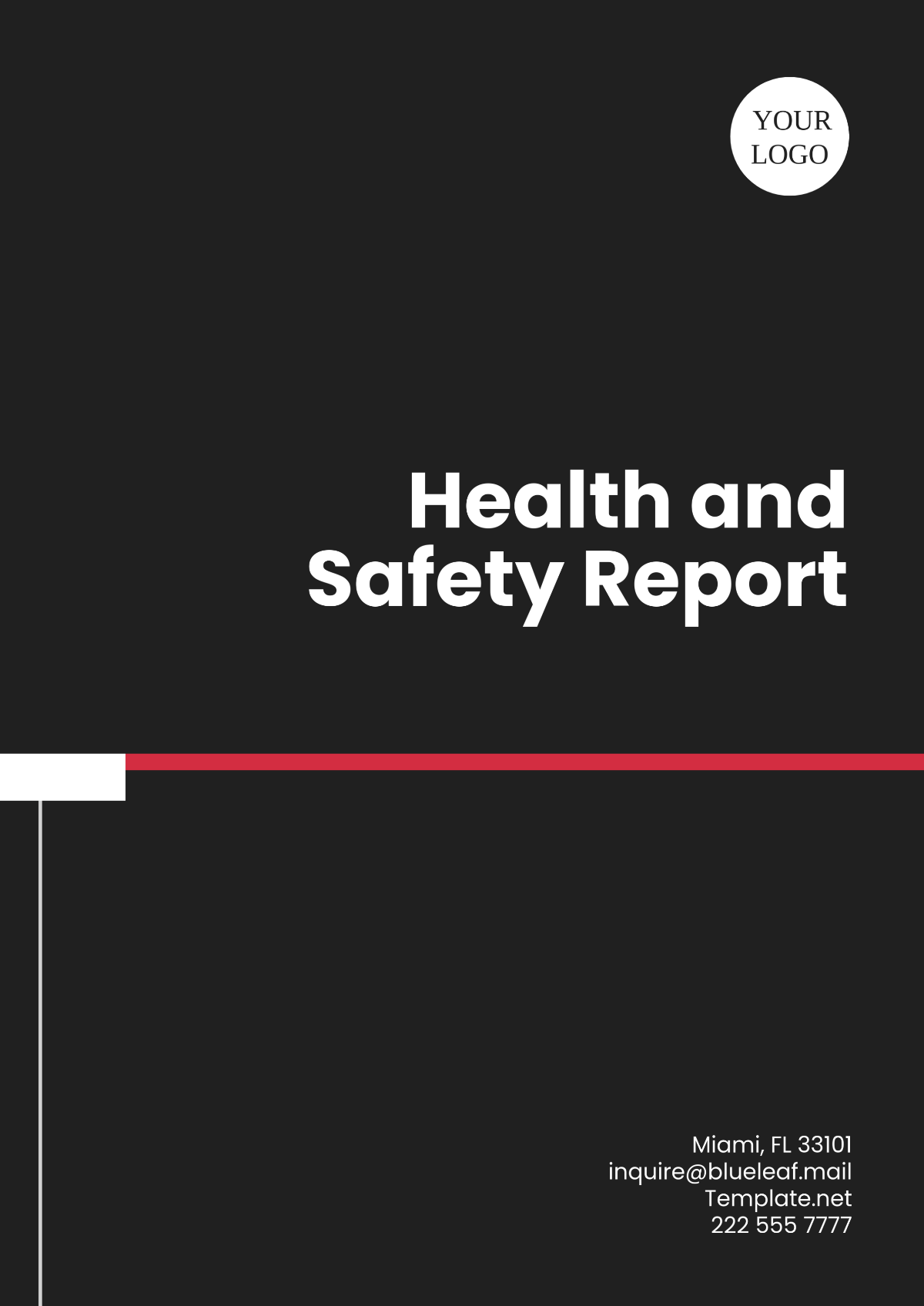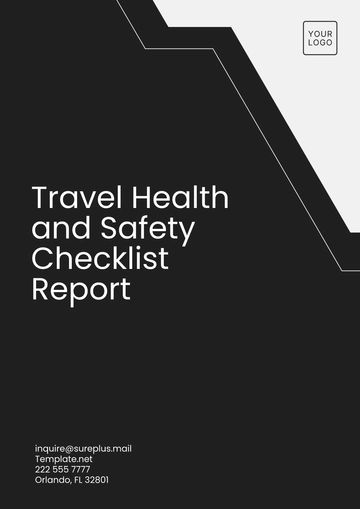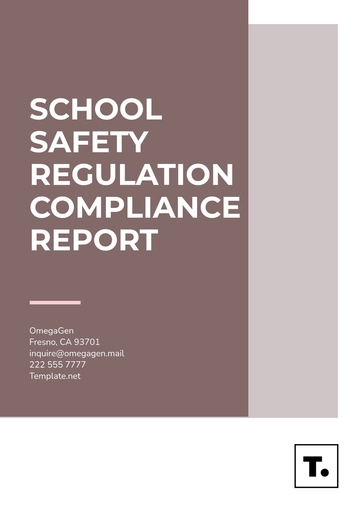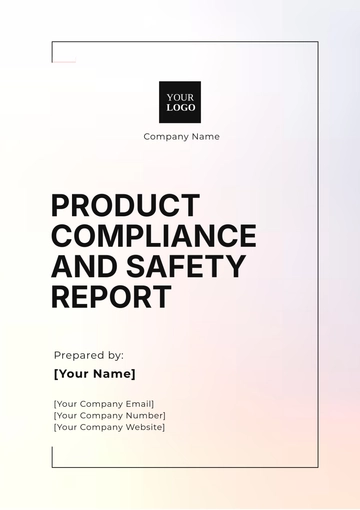Free Healthy and Safety Report

Prepared by: [Your Name]
Date: January 1, 2060
1. Introduction
This report comprehensively evaluates the organization's current health and safety practices. It highlights key areas of concern, assesses the effectiveness of existing measures, and proposes strategies for enhancement. Prioritizing the safety and well-being of employees and stakeholders is a legal obligation and a cornerstone of organizational success.
2. Objectives
The objectives of this health and safety report are to:
Evaluate Current Practices: Assess the effectiveness of existing health and safety policies.
Identify Workplace Hazards: Highlight potential risks to employees, clients, and stakeholders.
Analyze Incident Trends: Use report data to uncover patterns in accidents and near-misses.
Recommend Strategic Improvements: Propose actionable strategies to enhance safety protocols.
Ensure Regulatory Compliance: Maintain adherence to legal and industry-specific standards.
Promote a Safety-First Culture: Foster a proactive approach to health and safety at all levels of the organization.
3. Current Health and Safety Policies
3.1 General Safety Procedures
The organization has instituted several general safety procedures, including:
Regular safety drills, such as fire evacuations and first-aid training.
Mandatory use of safety gear in high-risk work areas.
Clear labeling and storage of hazardous materials to prevent accidental exposure.
Scheduled maintenance of equipment and infrastructure to ensure operational safety.
Comprehensive onboarding safety training for all new employees.
3.2 Health Policies
The organization's health policies aim to support employee wellness and include:
Provision of health insurance and wellness programs.
Regular health check-ups and workplace screenings.
Ergonomic workstations to reduce the risk of physical strain.
Access to mental health support services, including counseling and workshops.
Strict implementation of a no-smoking policy on company premises.
3.3 Emergency Response Plans
Emergency preparedness is vital for minimizing harm in critical situations. Key measures include:
Designated emergency response teams trained in evacuation protocols.
Availability of emergency kits, including first-aid supplies and fire extinguishers.
Detailed communication plans for coordinating responses during crises.
4. Risk Assessment
A comprehensive risk assessment identifies the following workplace hazards:
Risk Category | Description | Likelihood | Impact |
|---|---|---|---|
Physical | Slips, trips, and falls in wet or cluttered areas. | Medium | High |
Chemical | Exposure to hazardous substances in the workplace. | Low | Medium |
Biological | Risks of infection from pathogens or biohazards. | Low | High |
Psychosocial | Work-related stress and its effects on mental health. | High | Medium |
Ergonomic | Poor workstation design leading to musculoskeletal issues. | Medium | Low |
5. Incident and Accident Analysis
An analysis of incident reports over the last 12 months reveals:
An increase in slips and falls, particularly in areas prone to wetness.
Isolated cases of equipment malfunction, though incidents remain minimal.
Low occurrence of chemical-related incidents, reflecting effective handling protocols.
A noticeable rise in work-related stress cases, underscoring the need for enhanced mental health support.
6. Key Performance Metrics
To measure the organization's safety performance, the following metrics are monitored:
Incident Frequency Rate (IFR): The number of reportable incidents per 100,000 hours worked.
Average Response Time: The average time taken to address safety concerns or hazards.
Employee Feedback Score: Regular surveys gauge employee perceptions of safety measures.
Training Completion Rate: Percentage of employees completing mandatory safety training programs.
7. Recommendations
7.1 Improved Training and Awareness
Conduct role-specific safety training to address unique risks.
Implement annual refresher courses to keep safety knowledge current.
Introduce a gamified learning system to increase engagement during safety drills.
7.2 Enhanced Risk Management Practices
Establish routine inspections of high-risk areas to detect and mitigate hazards.
Appoint a dedicated Health and Safety Officer to oversee compliance and incident response.
Leverage digital tools for real-time hazard reporting and tracking.
7.3 Strengthened Mental Health Support
Expand access to mental health services, including stress management workshops.
Foster a supportive workplace culture that prioritizes work-life balance.
Conduct regular assessments to identify stress-related trends and their root causes.
7.4 Upgraded Safety Infrastructure
Install non-slip flooring in high-risk wet areas.
Modernize safety equipment to meet current industry standards.
Increase visibility of emergency exits and safety instructions through clear signage.
7.5 Policy Review and Employee Involvement
Establish a biannual review of health and safety policies to ensure relevance.
Create a feedback loop where employees can propose improvements to safety measures.
Reward teams or departments demonstrating exemplary safety practices.
8. Conclusion
Ensuring a safe and healthy work environment is an ongoing process that requires dedication, resources, and a commitment to continuous improvement. By addressing the identified concerns and implementing the proposed recommendations, the organization can enhance its health and safety culture, thereby safeguarding its most valuable asset—its people.
- 100% Customizable, free editor
- Access 1 Million+ Templates, photo’s & graphics
- Download or share as a template
- Click and replace photos, graphics, text, backgrounds
- Resize, crop, AI write & more
- Access advanced editor
Ensure workplace safety with the Healthy and Safety Report Template from Template.net! Fully customizable and editable, this professional template simplifies documentation. Easily tailor reports to your needs using our intuitive AI Editor Tool. Save time and ensure accuracy with this versatile solution designed for efficiency and compliance. Perfect for businesses prioritizing safety and organization!
You may also like
- Sales Report
- Daily Report
- Project Report
- Business Report
- Weekly Report
- Incident Report
- Annual Report
- Report Layout
- Report Design
- Progress Report
- Marketing Report
- Company Report
- Monthly Report
- Audit Report
- Status Report
- School Report
- Reports Hr
- Management Report
- Project Status Report
- Handover Report
- Health And Safety Report
- Restaurant Report
- Construction Report
- Research Report
- Evaluation Report
- Investigation Report
- Employee Report
- Advertising Report
- Weekly Status Report
- Project Management Report
- Finance Report
- Service Report
- Technical Report
- Meeting Report
- Quarterly Report
- Inspection Report
- Medical Report
- Test Report
- Summary Report
- Inventory Report
- Valuation Report
- Operations Report
- Payroll Report
- Training Report
- Job Report
- Case Report
- Performance Report
- Board Report
- Internal Audit Report
- Student Report
- Monthly Management Report
- Small Business Report
- Accident Report
- Call Center Report
- Activity Report
- IT and Software Report
- Internship Report
- Visit Report
- Product Report
- Book Report
- Property Report
- Recruitment Report
- University Report
- Event Report
- SEO Report
- Conference Report
- Narrative Report
- Nursing Home Report
- Preschool Report
- Call Report
- Customer Report
- Employee Incident Report
- Accomplishment Report
- Social Media Report
- Work From Home Report
- Security Report
- Damage Report
- Quality Report
- Internal Report
- Nurse Report
- Real Estate Report
- Hotel Report
- Equipment Report
- Credit Report
- Field Report
- Non Profit Report
- Maintenance Report
- News Report
- Survey Report
- Executive Report
- Law Firm Report
- Advertising Agency Report
- Interior Design Report
- Travel Agency Report
- Stock Report
- Salon Report
- Bug Report
- Workplace Report
- Action Report
- Investor Report
- Cleaning Services Report
- Consulting Report
- Freelancer Report
- Site Visit Report
- Trip Report
- Classroom Observation Report
- Vehicle Report
- Final Report
- Software Report





























